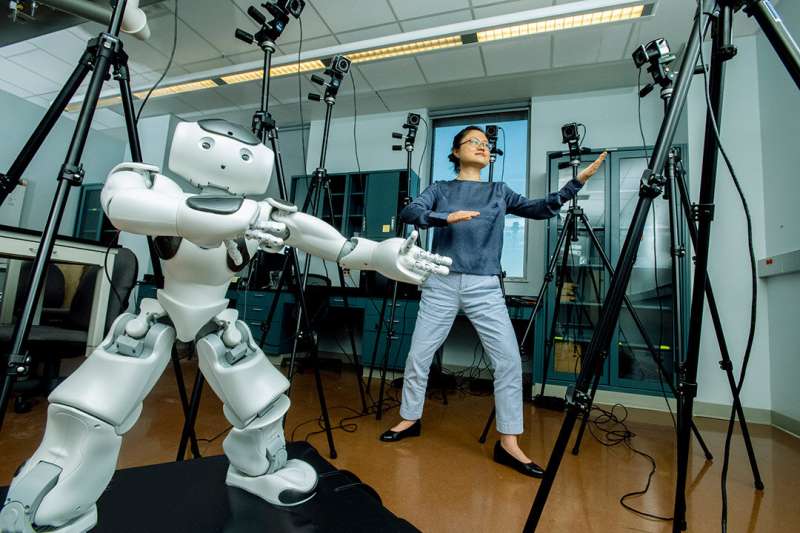
Zhi Zheng’s robot is skilled at Tai Chi, and her research team hopes it will soon lead a class of older adults at a local community center. Her robot is more than a cute companion. It can help improve cognitive function and provide insights about how people interact with robots in various settings.
Zheng, an assistant professor of biomedical engineering in RIT’s Kate Gleason College of Engineering, developed a sophisticated humanoid robot as part of her assistive technology research.
With expertise in developing robotics and virtual reality systems, Zheng’s work explores human-machine intelligence. She is part of a larger RIT cross-disciplinary team using artificial intelligence (AI) and robotics to design assistive technologies that can impact mental health care.
“My major research direction is for individuals with developmental disorders. Many core technologies are transferable to other populations such as older adults with mild cognitive impairment,” said Zheng, who leads the Intelligent Interaction Research Lab. The lab is focused on several funded technology-mediated initiatives including healthcare for older adults with multiple chronic conditions and interventions for individuals with Autism Spectrum Disorder (ASD).
The Tai Chi leader is an NAO Robot, and although only about 2 feet tall, it is a highly sophisticated system that can be programmed with specific functions and tasks.
“We don’t have to build our own robot hardware because there are good commercial platforms available. How it behaves solely depends on how we design the control programs. The central part of our research is how we control the robots to do the cognitive and physical instruction properly,” Zheng said. “The robot does not really know how to behave coming out of the box. We teach it how to function.”
Teaching it Tai Chi was one of those functions.
A popular mind-body exercise, Tai Chi consists of choreographed motions, meditation, and proper breathing. Different movements require the practitioner to rely on many cognitive functions such as working memory and visual-spatial processing to memorize the patterned gestures. Movement stimulates blood flow through the brain, and for older adults, this has been shown to be beneficial to longevity, memory, and learning.
Using robots as facilitators is a growing research field, and Zheng has seen movement from lab-based work to community-based field studies.
“There is a big difference. Everything in the lab is controlled, and people can be nervous and cautious. That does not really reflect their natural reactions,” she said. “Now the field is trying to understand and study what if we move the technology out of the engineering building to a community center, for example? People are relaxed, and their reactions will be more natural using new technology. Technology has to be easily controlled by a non-expert—that relates to our interface design. We want our robot to be operated by a leader or a social worker at the community center—because technology is designed to serve people. It has to fit in the community.”
Some onsite work was paused for a short time during the pandemic, but has since resumed with Zheng leading a research team that includes Victor Perotti, professor in Saunders College of Business; Yong Tai Wang, dean of the College of Health Sciences and Technology; Peter Bajorski, professor of statistics in the College of Science.
Wang brings more than 20 years of experience instructing and practicing Tai Chi, and Bajorski has worked previously with Zheng on a separate Department of Health and Human Services grant to measure aspects of ASD. Coupled with research in the area of the Theory of Mind—the study of human-robot interactions and the effectiveness of using robots as research facilitators—the team combines psychology and inter-personal communications with applications built on human-centered artificial intelligence, one of RIT’s key research areas.
“I think of myself as a user and builder of artificial intelligence because I design my own system frameworks, my own algorithms. Those are more elemental in the AI spectrum,” she said. “And I also look to other people’s work to add to my research. I’m standing on the shoulders of giants!”
Human-like robots may be perceived as having mental states
Citation:
Researchers develop humanoid robotic system to teach Tai Chi (2022, September 30)
retrieved 30 September 2022
from https://techxplore.com/news/2022-09-humanoid-robotic-tai-chi.html
This document is subject to copyright. Apart from any fair dealing for the purpose of private study or research, no
part may be reproduced without the written permission. The content is provided for information purposes only.
Stay connected with us on social media platform for instant update click here to join our Twitter, & Facebook
We are now on Telegram. Click here to join our channel (@TechiUpdate) and stay updated with the latest Technology headlines.
For all the latest Technology News Click Here
For the latest news and updates, follow us on Google News.
